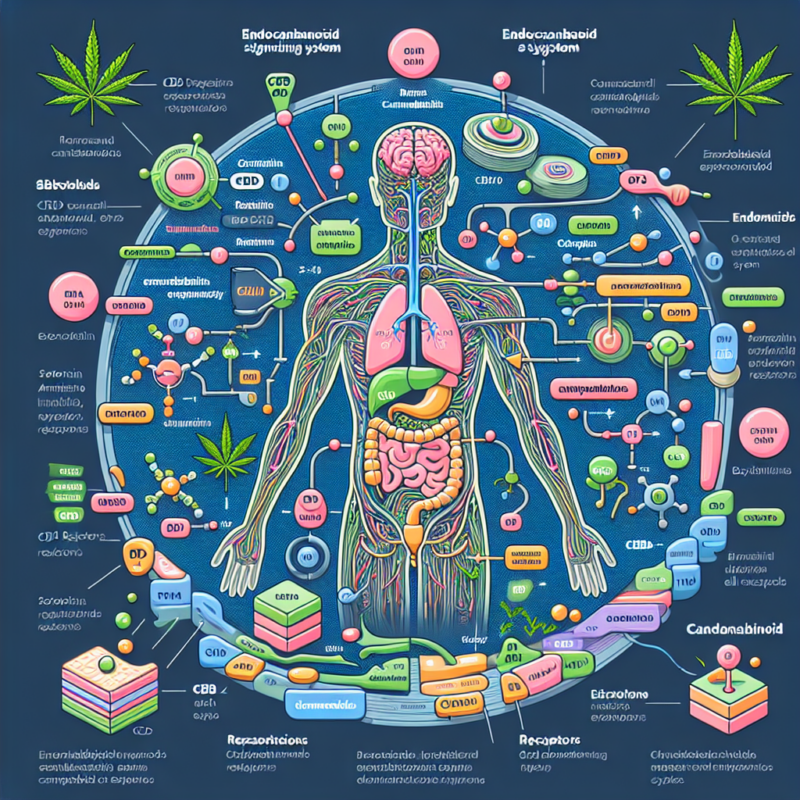Education
Decoding the Science: How Hemp CBD Works in Your Body
CBD is everywhere these days, from tinctures and gummies to lotions and even pet treats. But with its surging popularity, a crucial question remains: Do you really know how it works?” According to a 2019 Gallup poll, 14% of U.S. adults use CBD products. This blog aims to demystify the science behind CBD (cannabidiol), explaining how this non-psychoactive compound, derived from the hemp plant, interacts with your body to potentially offer a range of wellness benefits. The key to understanding CBD’s effects lies within a complex network called the Endocannabinoid System (ECS), a system that plays a vital role in regulating many of our body’s most important functions.
Section 1: The Endocannabinoid System (ECS) – Your Body’s Master Regulator
The Endocannabinoid System (ECS) is a sophisticated network of receptors, enzymes, and endocannabinoids that functions as a master regulator, helping to maintain homeostasis – a state of balance – within the body. Think of it as your body’s internal conductor, ensuring that various systems are working in harmony. The ECS influences a wide array of physiological processes, including mood, sleep, appetite, pain sensation, immune response, stress, and even memory. Dysregulation of the ECS has been implicated in various conditions, highlighting its importance in overall health [cite study linking ECS dysregulation to specific diseases].
The ECS comprises three main components:
-
Endocannabinoids: These are naturally produced cannabinoids within the body, acting as signaling molecules that bind to cannabinoid receptors. The two most well-studied endocannabinoids are anandamide (AEA) and 2-arachidonoylglycerol (2-AG). Anandamide, sometimes referred to as the “bliss molecule,” plays a role in mood regulation, pain relief, and appetite. 2-AG is involved in immune function, pain, and inflammation. Endocannabinoids are produced “on-demand” and broken down quickly after use, ensuring precise control over signaling.
-
Cannabinoid Receptors (CB1 and CB2): These receptors are located throughout the body and act as docking stations for endocannabinoids (and, as we’ll see, for CBD).
-
CB1 Receptors: Primarily found in the brain and central nervous system, CB1 receptors play a crucial role in cognitive function, mood regulation, pain perception, motor control, and memory. Activation of CB1 receptors can influence neurotransmitter release, affecting a wide range of neurological processes.
-
CB2 Receptors: Predominantly found in the immune system, CB2 receptors are involved in modulating inflammation and immune response. Activation of CB2 receptors can help to reduce inflammation and promote immune balance. While less prevalent in the brain than CB1 receptors, CB2 receptors are also found in microglia, the brain’s immune cells, where they play a role in neuroinflammation.
-
-
Enzymes: Enzymes are responsible for synthesizing and breaking down endocannabinoids. Fatty acid amide hydrolase (FAAH) is the primary enzyme that breaks down anandamide, while monoacylglycerol lipase (MAGL) breaks down 2-AG. By controlling the levels of endocannabinoids, these enzymes play a critical role in regulating ECS activity.
Analogy: Imagine the ECS as a sophisticated thermostat system in your home. The endocannabinoids are like the temperature sensors, constantly monitoring the internal environment. The CB1 and CB2 receptors are like the thermostat settings, determining the desired temperature range. And the enzymes are like the heating and cooling system, adjusting the temperature to maintain the set point. When the system is working properly, the temperature stays within a comfortable range. However, if the sensors are faulty, the thermostat is set incorrectly, or the heating/cooling system malfunctions, the temperature can fluctuate wildly, leading to discomfort. Similarly, when the ECS is dysregulated, it can lead to a variety of health problems.
Section 2: How CBD Interacts with the ECS
Unlike THC, the psychoactive compound in cannabis, CBD doesn’t directly bind to CB1 and CB2 receptors in the same way. Instead, CBD exerts its effects through a more indirect and nuanced mechanism of action. This indirect influence is what makes CBD non-intoxicating while still offering potential therapeutic benefits.
CBD’s Mechanisms of Action:
-
Inhibiting FAAH: One of the primary ways CBD interacts with the ECS is by inhibiting the enzyme FAAH, which breaks down anandamide. By slowing down the breakdown of anandamide, CBD can increase its levels in the brain and body. This can lead to enhanced mood, reduced anxiety, and pain relief, as anandamide is known to play a role in these processes.
-
Modulating Receptor Activity: While CBD doesn’t directly bind to CB1 and CB2 receptors, it can modulate their activity. For example, CBD may act as an allosteric modulator, meaning it can bind to a different site on the receptor and change its shape, thereby altering its response to other molecules. This can result in a more balanced and regulated ECS response.
-
Interacting with Other Receptors: CBD also interacts with other receptors in the body, including serotonin receptors (5-HT1A), vanilloid receptors (TRPV1), and GPR55 receptors [cite studies on CBD interacting with these receptors]. These interactions can contribute to CBD’s diverse range of effects, including anti-anxiety, anti-inflammatory, and neuroprotective properties.
-
Serotonin Receptors (5-HT1A): CBD’s interaction with serotonin receptors may contribute to its anti-anxiety and antidepressant effects.
-
Vanilloid Receptors (TRPV1): Activation of TRPV1 receptors can influence pain perception and inflammation.
-
GPR55 Receptors: CBD’s interaction with GPR55 receptors may play a role in bone health and cancer.
-
Conclusion:
Understanding how CBD interacts with the Endocannabinoid System is crucial for appreciating its potential benefits and using it effectively. While research is ongoing, the current evidence suggests that CBD exerts its effects through a complex interplay of mechanisms, including inhibiting FAAH, modulating receptor activity, and interacting with other receptors in the body. By understanding these mechanisms, we can gain a deeper appreciation for the science behind CBD and its potential to promote overall health and well-being. As always, it’s essential to consult with a healthcare professional before incorporating CBD into your wellness routine, especially if you have any underlying health conditions or are taking medications.
Important Considerations:
- Disclaimer: Include a standard disclaimer stating that this information is for educational purposes only and not intended as medical advice.
- Consult a Doctor: Emphasize the importance of consulting with a healthcare professional before using CBD.
- Quality and Sourcing: Briefly mention the importance of choosing high-quality CBD products from reputable sources.
- Future Research: Acknowledge that research on CBD is ongoing and that our understanding of its mechanisms of action is constantly evolving.

